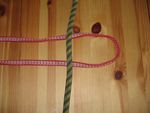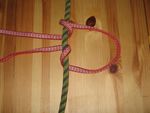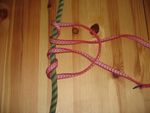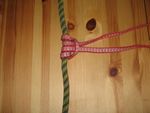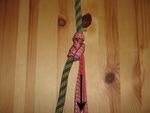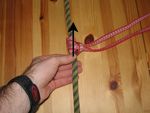Nó de Prussik
Texto retirado do Site: http://en.wikipedia.org/wiki/Prusik_knot
Prussik
O nó do Prussik, é um nó do tipo "blocante", que tem a característica de travar quando submetido a tensão, e correr quando frouxo. É o mais utilizado em escaladas e subidas por meio de corda por ser fácil e rápido.
Prusik (or Prussik or Prussic) is a friction hitch used in climbing, canyoneering, caving, rope rescue and by arborists to grab a rope (sometimes referred to as a rope-grab). The term Prusik is used both for the knot, for the loops of cord, and for the action (to prusik). More casually, the term is used for any friction hitch that can grab a rope.
The Prusik hitch is named for its inventor, Austrian mountaineer Dr. Karl Prusik. It was shown in a 1931 Austrian mountaineering manual for rope ascending. It was used on several mountaineering routes of the era to ascend the final summit block of a peak; where a rope could be thrown over the top, one side anchored, and climbers could attain the summit by prusiking up the other side of the rope.
Tying the Prusik
The Prusik is tied by wrapping the prusik loop around the rope a number of times (depending on the materials, but usually 3-5 times), and then back through itself, forming a barrel around the rope, with a tail hanging out the middle. When the tail is weighted the turns tighten around the main rope and grab. When weight is removed the loop can be slid along the rope by placing a hand directly on the barrel and pushing. The trick is, if it grabs well, then it is hard to slide along the rope. Breaking the Prusik free from the rope after it has been weighted can be difficult, and is easiest done by pushing the bow, being the loop of cord which runs from the top wrap, over the knot to the bottom wrap, along the tail a little. This loosens the grip of the hitch and makes movement easier.
